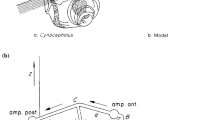Abstract
A precise balance of cupula and endolymph densities is key to the proper sensing of angular acceleration by the semicircular canals (SC). Estimates show that a density difference of cupula and endolymph (DD) as small as ~10 − 4 g/cm3 is sufficient to make the SC sensitive to gravity and centrifugal forces provided they are comparable with gravity. As a result this might cause vestibular disorders. There are conditions under which the DD may even exceed this value. One of them is a change of intra-labyrinth pressure (IP) that may take place during a spaceflight. Here, the effect of DD on SC dynamics is considered using a simplified one-dimensional toroidal mathematical model of a canal for rotation with constant or harmonically oscillating angular velocities. The DD results in: dependence of cupula dynamics on orientation of both the gravity vector relative to the SC plane and the axis of rotation, as well as on the distance between the axis of rotation and the center of SC; shift of the cupula to a new position of equilibrium that depends on both the gravity vector and the parameters of head rotation; and onset of cupula oscillations with multiple frequencies under harmonic stimulation. The DD effect may be important under conditions of artificial gravity where the directions of centrifugal forces, the values of which are comparable with Earth’s gravity, the orientations of the axis of rotation of a space station, and the axes of the SCs change during movements of the individuals and their habitat.
Similar content being viewed by others
Explore related subjects
Discover the latest articles and news from researchers in related subjects, suggested using machine learning.References
Adalsteinsson, E., Sullivan, E.V., Mayer, D., Pfefferbaum, A.: In vivo quantification of ethanol kinetics in rat brain. Neuropsychopharmacology 12, 2683–91 (2006)
Böhmer, A.: Hydrostatic pressure in the inner ear fluid compartments and its effects on inner ear function. Acta Oto-laryngol., Suppl. 507, 3–24 (1993)
Borelli, G., Guibbolini, M.E., Mayer-Gostan, N., Priouzeau, F., De Pontual, H., Allemand, D., Puverel, S., Tambutte, E., Payan, P.: Daily variations of endolymph composition: relationship with the otolith calcification process in trout. J. Exp. Biol. 206, 2685–2692 (2003)
Brandt, T.: Positional and positioning vertigo and nystagmus. J. Neurol. Sci. 95, 3–28 (1990)
Curthoys, I.S., Oman, C.M.: Dimensions of the horizontal semicircular duct, ampulla and utricle in human. Acta Oto-laryngol. (Stockh) 103, 234–261 (1987)
Fernandez, C., Goldberg, J.M.: Physiology of peripheral neurons innervating semicircular canals of the squirrel monkey. II. Response to sinusoidal stimulation and dynamics of peripheral vestibular system. J Neurophysiol. 34, 661–75 (1971)
Goldberg, J.M., Fernandez, C.: Responses of peripheral vestibular neurons to angular and linear accelerations in the squirrel monkey. Acta Oto-laryngol. 80, 101–110 (1975)
Hiruma, K., Numata, T.: Positional nystagmus showing neutral points. ORL 66, 46–50 (2004)
Koizuka, I., Takeda, N., Kubo, T., Matsunaga, T., Cha, C.I.: Effects of ethyl alcohol and heavy-water administration on vestibulo-ocular reflex in rabbits. ORL J Otorhinolaryngol Relat. Spec. 51, 151–155 (1989)
Kondrachuk, A.V., Sirenko, S.P., Boyle, R.: Effect of difference of cupula and endolymph densities on the dynamics of semicircular canal. J. Vest. Res. 18, 69–88 (2008)
Landau, L.D., Lifshitz, E.M.: Theory of Elasticity, 3rd edn. Pergamon, Oxford (1986)
Ledoux, A.: Activité electrique des nerves des canaux semicirculaires du saccule et de 1′ υτ ρι χλ ε chez la grenouille. Acta oto-rhino-laryng. Belg. 3, 335–349 (1949)
Lowenstein, O., Compton, G.J.: A comparative study of the responses of isolated first-order semicircular canal afferents to angular and linear acceleration, analyzed in the time and frequency domains. Proc. R. Soc. Lond., B. 202, 313–338 (1978)
Money, K.E., Myles, W.S.: Heavy water nystagmus and effects of alcohol. Nature 247, 404–405 (1974)
Oman, C.K., Young, L.R.: The physiological range of pressure (inference and cupola deflection in human semicircular canal. Acta Oto-laryngol. (Stockh.) 74, 324–331 (1972)
Rietz, R., Troia, B.W., Yonkers, A.J., Norris, T.W.: Glycerol-induced positional nystagmus in human beings. Otolaryngol. Head Neck Surg. 97, 282–287 (1987)
ter Braak, J.W.G.: Kann der Bogengangsapparat durch geradlinige Beschleunigung gereizt warden? Pflügers. Arch. Gesamte. Physiol. 238, 327–332 (1937)
Timm, C.: Physikalishe Vorgange bei der Labyrinthreizung. Z. Laryngol. Rhinol. 32, 237–251 (1953)
Yamauchi, A., Rabbitt, R.D., Boyle, R., Highstein, S.M.: Relationship between inner-ear fluid pressure and semicircular canal afferent nerve discharge. J. Assoc. Res Otolaryngol. 3, 26–44 (2002)
Yoshida, M., Lowry, L.D., Liu, J.J.: Effects of hyperosmotic solutions on endolymphatic pressure. Am. J. Otolaryngol. 6, 297–301 (1985)
Young, L.R.: Perception of the body in space: mechanisms. In: Darian-Smith, I. (ed.) Handbook of Physiology—The Nervous System III, pp. 978–1023. American Physiological Society, Bethesda (1984)
Author information
Authors and Affiliations
Corresponding author
Rights and permissions
About this article
Cite this article
Kondrachuk, A.V., Boyle, R.D. The Density Difference of Cupula and Endolymph Changes the Mechanics of Semicircular Canals. Microgravity Sci. Technol. 23, 433–438 (2011). https://doi.org/10.1007/s12217-011-9265-6
Received:
Accepted:
Published:
Issue Date:
DOI: https://doi.org/10.1007/s12217-011-9265-6




